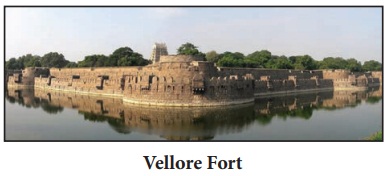People’s Revolt | Chapter 4 | History | 8th Social Science - Vellore Revolt (1806) | 8th Social Science : History : Chapter 4 : People’s Revolt
Chapter: 8th Social Science : History : Chapter 4 : People’s Revolt
Vellore Revolt (1806)
Vellore Revolt (1806)
The family members of Tipu were
imprisoned at Vellore fort after the fourth Mysore war. Some three thousand
ex-servants and soldiers of Hyder and Tipu had also been moved to the vicinity
of Vellore and their property in Mysore confiscated. It was quite natural that
they were all unhappy and they hatred the English.

The Vellore fort consisted of large
majority of Indian troops, a good part of it recently been raised in
Tirunelveli after the Palayakarar uprising of 1800. Many of the trained
soldiers of the various Palayams were admitted into the English army. Thus the
Vellore fort became the meeting ground of the rebel forces of South India.
In 1803, William Cavendish Bentinck
became Governor of Madras. During his period certain military regulations were
introduced in 1805-06 and were enforced by the Madras Commander-in-Chief Sir
John Cradock. But the sepoys felt that these were designed to insult them.
Causes for the revolt
* The strict discipline, new
weapons, new methods and uniforms were all new to the sepoys.
* The sepoys were asked to shave the
beard and to trim the moustache.
* The wearing of religious mark on
the forehead and the use of ear-rings were also banned.
* The English treated the Indian
sepoys as their inferior. There was the racial prejudice.
Immediate Cause
In June 1806, military General Agnew
introduced a new turban, resembling a European hat with a badge of cross on it.
It was popularly known as ‘Agnew’s turban’. Both the Hindu and Muslim soldiers
opposed it. So the soldiers were severely punished by the English.
Course of the Revolt
The Indian soldiers were waiting for
an opportunity to attack the English officers. Tipu’s family also took part.
Fettah Hyder, the elder son of Tipu, tried to form an alliance against the
English. On July 10th in the early morning the native sepoys of the 1st and
23rd Regiments started the revolt. Colonel Fancourt, who commanded the
garrison, was their first victim. The fort gates were closed. Meantime, the
rebels proclaimed Futteh Hyder, as their new ruler. The British flag in the
fort was brought down. The tiger-striped flag of Tipu Sultan was hoisted on the
fort of Vellore.
Suppression of the Revolt
Major Cootes who was outside the
fort rushed to Ranipet and informed Colonel Gillespie. Col. Gillespie reached
Vellore fort. He made an attack on the rebel force. The revolt was completely
suppressed and failed. Peace was restored in Vellore. On the whole, 113
Europeans and about 350 sepoys were killed in the uprising. The revolt was
suppressed within a short period. It was one of the significant events in the
history of Tamil Nadu.
Effects of the Vellore Revolt
* The new methods and uniform
regulations were withdrawn.
* The family of Tipu as a
precautionary measure was sent to Calcutta.
* William Cavendish Bentinck was
removed from his service.
Causes for the failure of the Revolt
* There was no proper leadership to
guide the soldiers properly.
* The rebellion was also not well
organised.
* Divide and Rule policy of the
English, split the unity of the Indians.
V.D. Savarkar calls the Vellore
revolt of 1806 as the prelude to the first War of Indian Independence in 1857
Related Topics